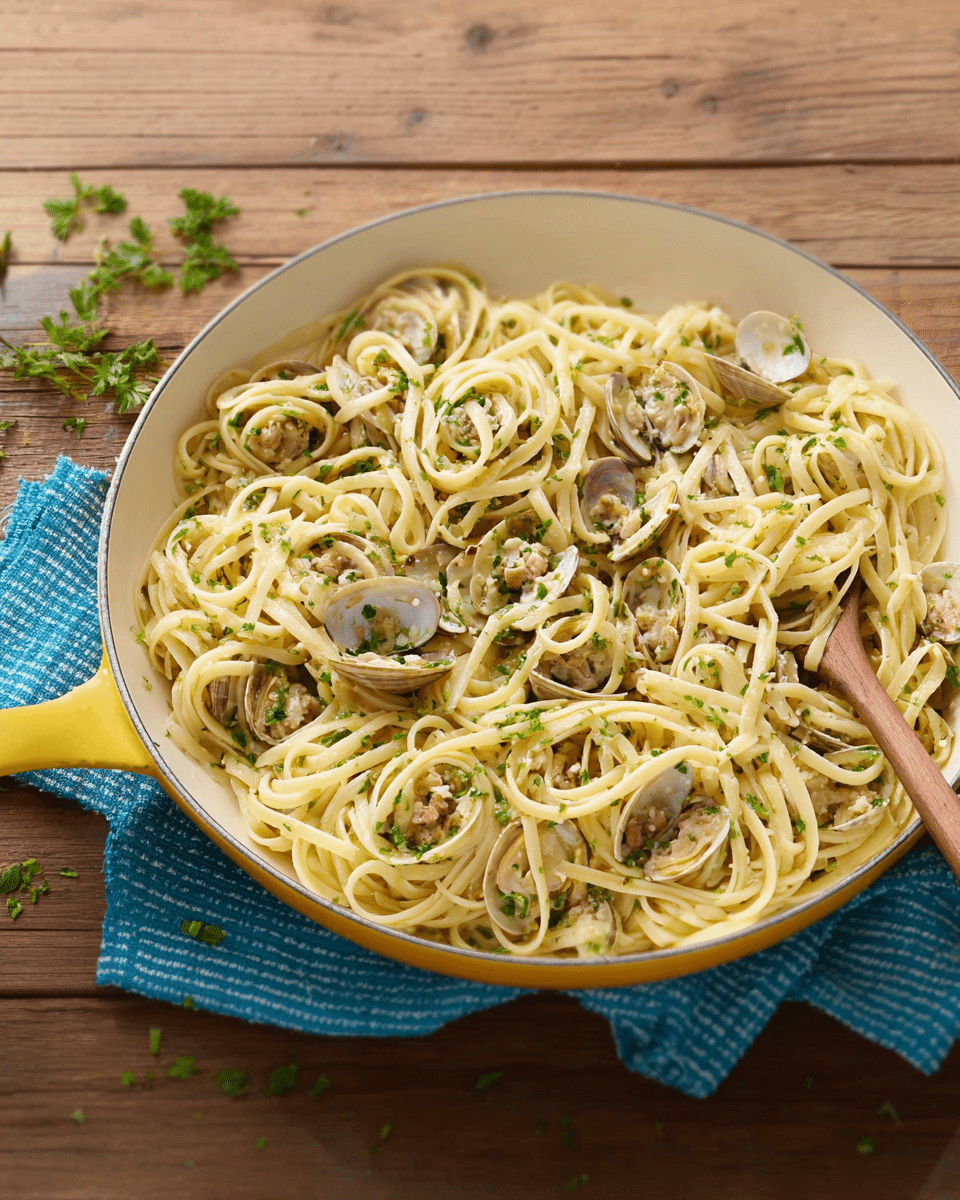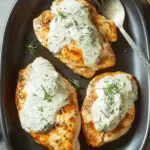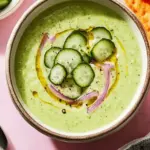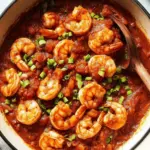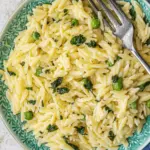The elegance of Linguine with Clams lies in its simplicity. Each element — from briny clams to zesty lemon and herby parsley — is designed to enhance the natural sweetness of the seafood. A quick sauté in garlic and white wine transforms these humble ingredients into a luxurious and aromatic dish that feels like summer in Italy.
Whether you’re craving a light seafood dinner or trying to impress guests with minimal effort, this dish delivers every time. It’s a one-pan wonder that’s ideal for warm evenings, romantic dinners, or an effortless showstopper for a small dinner party.
Full Recipe:
-
3 tablespoons olive oil
-
4 cloves garlic, minced
-
1/4 teaspoon red pepper flakes
-
1/2 cup dry white wine
-
2 pounds littleneck clams, scrubbed clean
-
1 tablespoon unsalted butter
-
1/4 cup chopped fresh parsley
-
Zest of 1 lemon
-
Salt and freshly ground black pepper, to taste
Directions:
-
Bring a large pot of salted water to a boil. Cook linguine until al dente according to package directions. Reserve 1/2 cup of pasta water, then drain.
-
In a large, deep skillet, heat olive oil over medium heat. Add garlic and red pepper flakes, sauté until fragrant, about 1 minute.
-
Add white wine and bring to a simmer. Add clams, cover the pan, and cook for 6-8 minutes or until clams open. Discard any that remain closed.
-
Add the cooked linguine to the skillet, along with the butter, lemon zest, and reserved pasta water. Toss to coat everything in the sauce.
-
Season with salt and pepper to taste. Stir in parsley just before serving.
-
Serve hot, optionally with crusty bread for dipping.
Prep Time: 10 minutes | Cooking Time: 15 minutes | Total Time: 25 minutes
Kcal: 460 kcal | Servings: 4 servings
Introduction to Linguine with Clams
Linguine with Clams, or Linguine alle Vongole, is a timeless Italian pasta dish that masterfully blends simplicity with sophistication. This coastal classic hails from the southern regions of Italy, especially Naples and the Amalfi Coast, where fresh seafood is central to everyday cuisine. Though modest in its ingredient list, it delivers bold, briny flavors that transport the diner straight to the seaside. The key to its charm lies in the balance between delicate clams, pungent garlic, herbaceous notes, and the subtle acidity of dry white wine—all brought together over perfectly cooked linguine.
As one of the cornerstones of Southern Italian cooking, Linguine with Clams is cherished not just for its taste but also for its versatility and minimal preparation time. It exemplifies the Italian philosophy of letting high-quality ingredients speak for themselves without overcomplicating the process.
The Origins and Italian Influence
The roots of Linguine alle Vongole trace back to the Campania region, with Naples often cited as the birthplace of this dish. Italian coastal communities have long relied on the sea for sustenance, and clams—being abundant, flavorful, and affordable—have naturally found their way into many local recipes.
In Italy, you’ll typically find two main versions of this dish: bianco (white) and rosso (red). The white version, which this recipe follows, uses garlic, olive oil, white wine, and parsley. The red version incorporates tomatoes or tomato sauce, giving it a heartier feel. Both are equally respected, but the white version allows the briny sweetness of the clams to shine more clearly.
The pasta shape also plays a role. Linguine, a flat, narrow noodle, is ideal because it clings to the light sauce without overpowering the delicate shellfish.
Why This Dish is Loved Around the World
Part of the dish’s global popularity lies in its simplicity and rapid preparation. Unlike heavy cream-based pastas or labor-intensive baked dishes, Linguine with Clams can be prepared in under 30 minutes. That makes it a go-to for busy weeknights or impromptu dinner parties when you still want to impress.
But beyond convenience, the flavor profile of Linguine with Clams is deeply satisfying. The interplay of umami-rich clams, aromatic garlic, zesty lemon, and herbal parsley creates a layered experience with every bite. The wine adds depth without overpowering the natural saltiness of the clams, and the optional addition of red pepper flakes can bring a pleasant heat for those who enjoy a kick.
It’s a light yet filling dish that doesn’t leave you feeling weighed down—perfect for warm weather, coastal dinners, or even festive holiday meals like Christmas Eve’s Feast of the Seven Fishes.
Choosing the Right Clams
One of the most crucial aspects of a successful Linguine with Clams lies in choosing fresh, quality shellfish. Littleneck clams are a popular choice due to their small size and tender texture, but you may also encounter Manila clams or cockles in various recipes.
Always ensure your clams are scrubbed clean before cooking. If any remain closed after cooking, they should be discarded, as that indicates they weren’t alive prior to cooking. Using fresh clams over canned options dramatically elevates the flavor, offering a natural brininess that can’t be replicated in processed versions.
If you’re in a landlocked area, frozen clams are a viable alternative, though the flavor may be slightly less nuanced. Some gourmet markets even sell vacuum-sealed pre-cleaned clams, which can be a helpful shortcut while still maintaining quality.
Mastering the Sauce
What makes this dish memorable is its delicate sauce—a blend of extra virgin olive oil, garlic, white wine, and clam juices. It’s thin but intensely flavorful. There’s no need for cream or butter-heavy additions here; instead, the sauce gets its richness from emulsifying with the starches released by the pasta during cooking.
Many chefs swear by reserving a bit of the pasta water and adding it back into the skillet when tossing the linguine. This not only helps bind the sauce to the noodles but also slightly thickens it, creating a glossy finish that clings beautifully to each strand of pasta.
Timing is key. You want to add the linguine to the sauce while it’s still al dente, letting it finish cooking in the mixture of wine and clam juices so it absorbs all those flavors.
Flavor Enhancements and Optional Additions
While purists may stick with the core ingredients, there are plenty of ways to make this dish your own without losing its integrity. A light zesting of lemon just before serving brings brightness to the dish and cuts through any residual brininess. A small pat of butter added at the end can soften the acidity and give the sauce a silkier texture.
For a bit more complexity, some cooks add anchovies to the garlic and oil base for extra umami. Others like to sprinkle crushed red pepper flakes to add warmth. Fresh herbs beyond parsley—such as basil or thyme—can also add another layer of depth.
Grated cheese is traditionally avoided in seafood pasta in Italy, but rules are more relaxed in home kitchens. If you love it, a sprinkle of pecorino romano or parmesan won’t hurt the overall flavor, though it may compete with the seafood notes.
Pairing Suggestions
When it comes to drinks, the natural pairing for Linguine with Clams is a crisp, dry white wine. Think Pinot Grigio, Vermentino, or Sauvignon Blanc—wines that mirror the dish’s acidity and freshness without overpowering the clams. Champagne or other dry sparkling wines can also be an elegant match, especially for celebrations.
For side dishes, keep it light and fresh. A simple arugula salad with lemon vinaigrette, grilled asparagus, or roasted cherry tomatoes can complement the pasta beautifully without overshadowing it. Crusty Italian bread is practically a requirement to soak up any leftover sauce on the plate.
Presentation and Serving Tips
Presentation doesn’t have to be elaborate. A shallow pasta bowl or a large white plate will make the golden sauce and the clamshells pop visually. Don’t be afraid to scatter a few clams on top with their shells still intact—it adds a rustic, inviting touch that signals freshness.
Garnish with freshly chopped parsley and a few curls of lemon zest for added color and aroma. Serve immediately while everything is piping hot for the best flavor and texture.
A Perfect Dish for All Seasons
Although it feels summery thanks to the lemon and seafood, Linguine with Clams is a recipe that adapts well to all seasons. In colder months, it offers a comforting yet elegant option that doesn’t rely on heavy ingredients. During spring and summer, it feels light and vibrant, perfect for outdoor dining or paired with chilled white wine.
This versatility also extends to different dining occasions. It works as a solo dinner for two, an upscale lunch, or the centerpiece of a multi-course meal. You can even batch up the components and serve it family-style for a crowd.
Conclusion
Linguine with Clams is more than just a pasta dish—it’s a celebration of simplicity, freshness, and coastal Italian tradition. With minimal ingredients and little time investment, it delivers restaurant-quality results that feel indulgent yet refined. The interplay of oceanic brininess, garlicky richness, and herbal lift creates a flavor profile that’s universally beloved and endlessly adaptable.
Whether you’re a seafood lover looking for a new weeknight staple or a home cook eager to impress, Linguine with Clams deserves a spot in your recipe repertoire. With the right clams, a splash of good wine, and attention to timing, this dish offers a memorable experience that captures the essence of Italian culinary elegance—one delicious twirl at a time.

